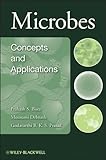Microbes : concepts and applications / Prakash S. Bisen, Mousumi Debnath, Godavarthi B.K.S. Prasad.
Material type: TextPublication details: Hoboken, N.J. : Wiley-Blackwell, 2012.Description: 1 online resource (xv, 699 pages :) : illustrationsContent type:
TextPublication details: Hoboken, N.J. : Wiley-Blackwell, 2012.Description: 1 online resource (xv, 699 pages :) : illustrationsContent type: - text
- computer
- online resource
- 9781118311905
- 0470905948
- 9780470905944
- 9781282000377
- 1282000373
- 1118311906
- 9781118311905
- 9781118311912
- 1118311914
- 616.9/041 23
- QR41.2 .B576 2012eb
Includes bibliographical references and index.
Machine generated contents note: Preface Acknowledgments Chapter 1. Human and Microbial World 1.1 Prologue 1.2 Innovations in microbiology for human welfare 1.3 The microbial world 1.4 Future challenges: Metagenomics Chapter 2. Gene Technology: Application and Techniques 2.1 Prologue 2.2 Introduction to Gene technology 2.3 Nucleic acid hybridization 2.4 DNA sequencing 2.5 Polymerase chain reaction 2.6 Omics technology and Microbes 2.7 Bioinformatics in microbial technology 2.8 Future challenges: The Biochips Chapter 3. Molecular Diagnostic and Medical Microbiology 3.1 Prologue 3.2 Microbial biology 3.3 Infection and immunity 3.4 Bacterial pathogens and associated diseases 3.5 Viral pathogen and associated diseases 3.6 Prions 3.7 Parasitic infections 3.8 Fungal pathogen 3.9 Microbial diagnostics 3.10 Future challenges: Promises of pharmacogenomics and molecular testing Chapter 4. Identification and Classification of Microbes 4.1 Prologue 4.2 Principles of taxonomy 4.3 Using phenotypic characteristics to identify microbes 4.4 Using genotypic character to identify microbes 4.5 Characterizing strain differences 4.6 Classification of microbes on the basis of phenotypic characteristics 4.7 Classification of microbes on the basis of genotypic characteristics 4.8 Future challenges: Aptamers for detection on pathogens Chapter 5. Diversity of Microorganisms 5.1 Prologue 5.2 Physiology diversity of micro organism 5.3 Thriving in terrestrial environment 5.4 Aquatic environment 5.5 Animal as habitat 5.6 Arachea in extreme environment 5.7 Biogeochemical cycling 5.8 Environmental influence and control of microbial growth 5.9 Micro organism and organic pollutants 5.10 Micro organism and metal pollutants 5.11 Environmentally transmitted pathogens 5.12 Microbes as friends of man 5.13 Microbes as disastrous enemy 5.14 Future challenges: Microbes in space Chapter 6. Microbes in Agriculture 6.1 Prologue 6.2 The soil plant micro organism 6.3 Root microbial interaction 6.4 Pathogenic microbes in agriculture 6.5 Microbes as a tool of genetic engineering 6.6 Future challenges: Functional genomic approach for improvement of crops Chapter 7. Microbes as a Tool for Industry and Research 7.1 Prologue 7.2 Historical development 7.3 Clinical diagnostics in a new era 7.4 Industrial microorganisms and product formation 7.5 Major industrial products for health and industry 7.6 Food diagnostics, preservation and food borne microbial diseases 7.7 Future challenges: Next generation diagnostics industry.
"This book connects the basic biology of microbes, microbial biodiversity, advances in microbialomics, and the role microbes play in modern biotechnology, agriculture, food science, and environmental remediation. In short, it offers the most complete treatment of microbial biology available. Each chapter contains a detailed account of what is known about the microbes and how key discoveries were made, the latest advances in microbialomics, and future directions, many of which may inspire current undergraduate and graduate students in their own research in medicine, biotechnology, or environmental science"-- Provided by publisher.
Cover; Title Page; Copyright; Preface; Acknowledgments; Chapter 1: Human and Microbial World; 1.1. Prologue; 1.2. Innovations in Microbiology for Human Welfare; 1.3. The Microbial World; 1.4. Future Challenges: Metagenomics; References; Chapter 2: Gene Technology: Applications and Techniques; 2.1. Prologue; 2.2. Introduction to Gene Technology; 2.3. Nucleic Acid Hybridization; 2.4. DNA Sequencing; 2.5. Polymerase Chain Reaction; 2.6. Omics Technology and Microbes; 2.7. Bioinformatics in Microbial Technology; 2.8. Future Challenges: The Biochips; References.
4.5. Characterizing Strain Differences4.6. Classification of Microbes on the Basis of Phenotypic Characteristics; 4.7. Classification of Microbes on the Basis of Genotypic Characters; 4.8. Future Challenges: Aptamers for Detection of Pathogens; References; Chapter 5: Diversity of Microorganisms; 5.1. Prologue; 5.2. Physiological Diversity of Microorganisms; 5.3. Thriving in Terrestrial Environment; 5.4. Aquatic Environment; 5.5. Animals as Habitat; 5.6. Archaea in Extreme Environments; 5.7. Biogeochemical Cycles; 5.8. Environmental Influence and Control of Microbial Growth.
5.9. Microorganisms and Organic Pollutants5.10. Microorganisms and Metal Pollutants; 5.11. Environmentally Transmitted Pathogens; 5.12. Microorganisms as Friends of Man; 5.13. Microbes as a Disastrous Enemy; 5.14. Future Challenges: Microbes in the Space; References; Chapter 6: Microbes in Agriculture; 6.1. Prologue; 6.2. The Soil Plant Microorganisms; 6.3. Root Microbial Interaction; 6.4. Pathogenic Microbes in Agriculture; 6.5. Microbes as a Tool of Genetic Engineering; 6.6. Future Challenges: Functional Genomics Approach for Improvement of Crops; References.
Chapter 3: Medical Microbiology and Molecular Diagnostics3.1. Prologue; 3.2. Microbial Biology; 3.3. Infection and Immunity; 3.4. Bacterial Pathogens and Associated Diseases; 3.5. Viral Pathogens and Associated Diseases; 3.6. Prions; 3.7. Parasitic Infections; 3.8. Fungal Pathogen; 3.9. Microbial Diagnostics; 3.10. Future Challenges: Promises of Pharmacogenomics; References; Chapter 4: Identification and Classification of Microbes; 4.1. Prologue; 4.2. Principles of Taxonomy; 4.3. Using Phenotypic Characteristics to Identify Microbes; 4.4. Using Genotypic Character to Identify Microbes.
Chapter 7: Microbes as a Tool for Industry and Research7.1. Prologue; 7.2. Historical Development; 7.3. Clinical Diagnostics in a New Era; 7.4. Industrial Microorganisms and Product Formation; 7.5. Major Industrial Products for Health and Industry; 7.6. Food Diagnostics, Food Preservation, and Foodborne Microbial Diseases; 7.7. Future Challenges: Next Generation Diagnostics Industry; References; Index; Color Plates.
Biotechnology & Bioinformatics
